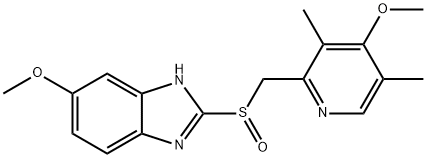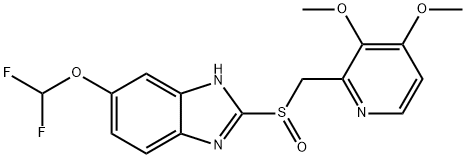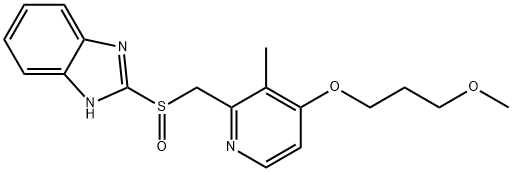Dexlansoprazole , ≥97% , 138530-94-6
Synonym(s):
(R)-(+)2-([3-methyl-4-(2,2,2-trifluoroethoxy)pyridin-2-yl]methylsulfinyl)-1H-benzo[d]imidazole;(R)-(+)-Lansoprazole
CAS NO.:138530-94-6
Empirical Formula: C16H14F3N3O2S
Molecular Weight: 369.36
MDL number: MFCD13196699
EINECS: 1308068-626-2
| Pack Size | Price | Stock | Quantity |
| 50MG | RMB23.20 | In Stock |
|
| 250MG | RMB46.40 | In Stock |
|
| 1G | RMB128.80 | In Stock |
|
| 5G | RMB518.40 | In Stock |
|
| 25g | RMB2062.40 | In Stock |
|
| 100g | RMB3999.20 | In Stock |
|
| others | Enquire |
PRODUCT Properties
| Melting point: | 66-68?C |
| Boiling point: | 555.8±60.0 °C(Predicted) |
| Density | 1.50±0.1 g/cm3(Predicted) |
| storage temp. | Sealed in dry,2-8°C |
| solubility | Chloroform (Slightly), DMSO (Slightly), Methanol (Slightly) |
| form | Solid |
| pka | 9.56±0.10(Predicted) |
| color | Off-White to Dark Brown |
| optical activity | [α]/D +142 to +158°, c =1 in chloroform-d |
| Stability: | Hygroscopic |
Description and Uses
The mechanism of PPIs involves the irreversible binding to the hydrogen/potassium adenosine triphosphatase enzyme system, commonly referred to as the gastric proton pump, of the gastric parietal cell. As the last stage in gastric acid secretion, blockade of the gastric proton pump is an effective treatment for a variety of diseases requiring acid suppression, such as heartburn, peptic ulcers, and GERD. Dexlansoprazole is the latest PPI to hit the market, joining the ranks of omeprazole, rabeprazole, pantoprazole, esomeprazole, and lansoprazole, and is the Renantiomer of the racemic lansoprazole. Compared to its predecessors, dexlansoprazole exhibits improved pharmacokinetics with slower clearance and longer terminal half-life. In addition, dexlansoprazole utilizes a novel DDR technology; drug release is optimized through the use of granules with different pH-dependent dissolution profiles, thereby providing an initial release in the proximal small intestine within 1-2 h of administration followed by a subsequent release at distal regions of the small intestine several hours later. With its longer duration of action culminating in more effective acid suppression, dexlansoprazole may have an advantage over conventional PPIs that possess single release formulations (immediate or delayed). Similar to all PPIs, dexlansoprazole is a prodrug that consists of pyridine and benzimidazole rings with a latent sulfenamide moiety. In order to form the disulfide bond with cysteine residues of the proton pump, dexlansoprazole must be activated through two protonations followed by a spontaneous rearrangement to unmask the sulfenamide.
Acts as a gastric proton pump inhibitor and an antiulcerative
Safety
| Symbol(GHS) |   GHS08,GHS07 |
| Signal word | Warning |
| Hazard statements | H317-H373 |
| Precautionary statements | P260-P314-P501-P261-P272-P280-P302+P352-P333+P313-P321-P363-P501 |





